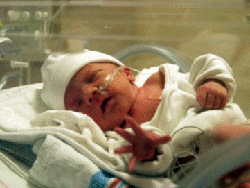
Bronchopulmonary Dysplasia (BPD)
What is bronchopulmonary dysplasia?

Bronchopulmonary dysplasia (BPD) is commonly found in premature infants. Though it is most often diagnosed as a prenatal complication, BPD has recently been seen in adults with Adult Respiratory Distress Syndrome. Approximately 5,000 to 10,000 new cases of BPD occur each year.
Causes
Infants exposed to high levels of oxygen therapy and those who have been on a ventilator for extended periods of time are most susceptible. Primary risk factors include prematurity, respiratory infection, congenital heart disease or any other severe illness requiring oxygen therapy or ventilators.
Symptoms
Common symptoms include rapid breathing, bluish skin and shortness of breath.
Treatment
Newborns with BPD typically require an average of 120 days of hospital care, followed by 90 days of home oxygen therapy.